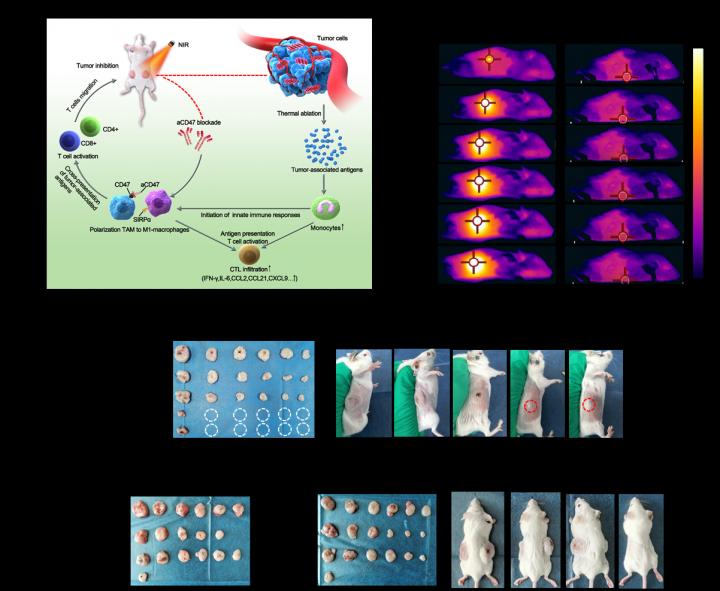
Credit: by Zhongjian Xie, Minhua Peng, Ruitao Lu, Xiangying Meng, Weiyuan Liang, Zhongjun Li, Meng Qiu, Bin Zhang, Guohui Nie, Ni Xie, Han Zhang & Paras N. Prasad
The immunosuppression status within most tumors is a great challenge for the efficacy of immune checkpoint blockade, as no efficient or durable antitumor immune response would be set up or maintained. Ablation effect of photothermal therapy could cause immunogenic cell death and subsequently released damaged-associated molecular patterns act as an endogenous danger signal, hence improving the tumor immunogenicity. To improve the success rate of the therapeutic effect of immune checkpoint blockade, it would be desirable to combine with photosensitizers to potentiate antitumor immunity.
Anti-CD47 antibody (aCD47), a CD47/SIRPα axis blockade agent, has demonstrated excellent efficacy against various kinds of tumors. However aCD47 as monotherapy induces modest phagocytic activity and low response rate , resulting in failures in clinical trials. In a new paper published in Light Science & Application, a team of scientists, led by Professor Han Zhang and Professor Paras N. Prasad, reported the use of near-infrared light-induced heat to ablate tumor together with aCD47 for enhanced cancer treatment.
These scientists summarize the mechanism of this combination strategy:
- (1) BP based photothermal effect could not only directly destroy or even kill tumor cells, but also initiate the innate immune responses and trigger CTL mediated adaptive immunity, thus serving as an effective specific immunological stimulator to improve the inherently poor immunogenicity of tumors.
(2) Light-irradiated BP in combination with aCD47, strongly suppresses proliferation and growth of cancer cells, exerting a significant synergistically enhanced antitumor effect.
(3) BP based hyperthermic ablation plus aCD47 treatment may induce abscopal effect and promises for inhibition of metastatic cancers.
“In short, BP based photothermal effect moderates immunosuppression in a tumor microenvironment , which further enhances antitumor immunities to facilitate aCD47 blockade cancer immunotherapy. The innate and adaptive immunity activated by BP photothermal effect plus aCD47 combined therapy leads to promotion of local and systemic anticancer immune responses. This combination strategy provides a promising platform to enhance the therapeutic efficacy of aCD47 in solid tumors. Given the excellent biodegradability property of BP, it is possible that this light-induced synergistic therapy mode has great potential in biomedical applications and clinical translation.”
###
Media Contact
Paras N. Prasad
[email protected]
Related Journal Article
http://dx.




